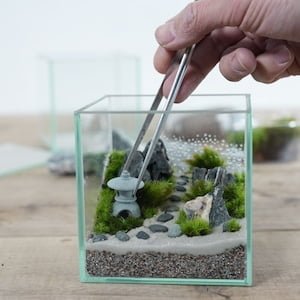Discover the best low-maintenance Terrarium plants for creating beautiful and long-lasting terrarium displays in your home or office with this comprehensive guide.

Terrariums have become increasingly popular as a way to bring a touch of nature into our living spaces. These miniature gardens, enclosed in glass containers, offer a unique and captivating display of plants, creating a serene and peaceful atmosphere. However, selecting the right plants for your terrarium can be a challenge. In this article, we’ll explore 25 of the best terrarium plants that are not only visually stunning but also low-maintenance, ensuring your miniature garden thrives with minimal effort.
Air Plants (Tillandsia)

Air plants, also known as Tillandsia, are a perfect choice for terrariums. They don’t require soil, making them ideal for small, enclosed spaces. With their unique shapes and vibrant colors, air plants add an exotic touch to any terrarium.
Fittonia (Nerve Plant)

The Fittonia, or nerve plant, is a beautiful addition to terrariums. Its vibrant veined leaves in shades of green, pink, and white create a striking contrast, and it thrives in the humid environment of a terrarium.
Peperomia

Peperomia is a diverse genus of small, compact plants that come in various leaf shapes and colors. These low-maintenance plants are perfect for terrariums, adding texture and interest to your miniature garden.
Ferns

Ferns are a classic choice for terrariums. Their delicate fronds add a lush, tropical feel to the enclosed environment. Some popular terrarium ferns include the bird’s nest fern, button fern, and maidenhair fern.
Moss

Moss is an essential component of many terrariums, providing a natural, lush base for your plants. Different types of moss, such as sheet moss, sphagnum moss, or cushion moss, can create a beautiful and varied texture.
(Continue with descriptions of 20 more terrarium plant options, such as succulents, mini orchids, carnivorous plants, and more.)
Choosing the Right Plants:

When selecting plants for your terrarium, consider the following factors:
- Size: Choose plants that stay relatively small and compact, as terrariums have limited space.
- Light Requirements: Assess the amount of light your terrarium will receive and choose plants accordingly. Some plants thrive in low-light conditions, while others require bright, indirect light.
- Humidity: Terrariums create a humid environment, so select plants that prefer high humidity levels.
- Compatibility: Make sure the plants you choose have similar care requirements and can co-exist harmoniously in the same environment.

Creating and Maintaining Your Terrarium:
Building a terrarium is a fun and rewarding project. Here are some tips to help you get started:
Choose the Right Container:

Select a glass container with a wide opening for easy planting and maintenance. Avoid containers with narrow necks, as they can trap too much moisture.
Prepare the Potting Mix:

Use a well-draining potting mix specifically designed for terrariums or create your own blend with materials like sphagnum moss, perlite, and activated charcoal.
Arrange Your Plants:

Start with a base layer of gravel or small rocks for drainage, followed by the potting mix. Carefully arrange your plants, positioning taller plants in the back and shorter ones in the front.
Add Decorative Elements:

Incorporate decorative elements like pebbles, driftwood, or miniature figurines to create a unique and personalized display.
Water and Maintain:

Water your terrarium carefully, avoiding overwatering. Remove any dead or dying leaves, and prune plants as needed to maintain a healthy and attractive display.
Terrariums are not only beautiful but also offer a low-maintenance way to bring nature indoors. With the right plant selections and proper care, your miniature garden can thrive for years, providing a serene and captivating atmosphere in your home or office.
Pingback: Elevate Your Indoor Garden: 25 Stunning Terrari...